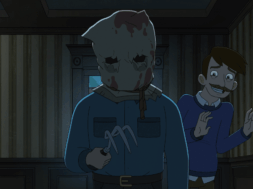Last year’s release of Resident Evil 7: Biohazard proved there’s still a lot of life left in popular horror video game franchises, given enough ingenuity and creativity. Its success leaves the door open for more series to follow suit, and one that I most hope follows Resident Evil’s footsteps is the often-overlooked Fatal Frame series. The first entry first dropped on the Playstation 2 in 2001 in native Japan before coming stateside in early 2002, and along with its immediate two sequels, it remains among the most terrifying survival horror video games ever.
Created by Makoto Shibata and Keisuke Kikichi with the intent of crafting the scariest game experience possible, the series spans 5 main entries, one of which never saw North American release. Admittedly, the concept behind the series, where the player is pitted against ghosts with only a camera as a weapon, didn’t seem as scary. Yet, the atmospheric Japanese setting, the unpredictable ghosts wrapped in haunting folklore, and the gameplay mechanics all combined into a chilling journey.
The creators utilized the setting to consistently keep players on edge; sometimes paranormal activity meant a ghostly battle was about to begin. Sometimes, it was simply employed for the sake of scares. That major unpredictability factor was used again and again on the player, as not even putting the game on pause for a period would give reprieve from scare tactics. It didn’t help that the narratives would consistently lean towards tragic, with often surprising twists and sometimes even incestuous leanings.
Fatal Frame
Set in 1986, the plot sees the protagonist controlling Miku Hinasaki, a young girl that arrives at the Himuro Mansion in search of her missing brother Mafuyu. Mafuyu disappeared while conducting a search of his tutor and his tutor’s assistants. The isolated mountainside mansion made for a creepy place for Miku to explore, armed with only a flashlight in the dark. Once the player discovers the only weapon, the Camera Obscura, the encounters with ghosts get unnerving.
The further Miku gets in her search, the more mysterious rope marks begin to appear on her skin. It’s the beginning of the complex occult and folklore narratives that became the series trademark. For Miku, the rope marks lead to uncovering the dark ritual gone wrong that began the curse; the mansion was a setting that held the portal to hell and a sacrifice of a shrine maiden kept evil at bay. When a sacrifice was derailed by love, evil was let loose.
Borrowing from franchises before it, namely Silent Hill and Resident Evil, Fatal Frame had multiple endings depending on the player’s gameplay. Nearly all of them were tinged with tragedy. The compelling mystery and the word of mouth reputation for frights meant a sequel would follow in 2003.
Fatal Frame II: Crimson Butterfly
The sequel proved to be the best game of the series. Because the first game terrified so many to the point where they were unable to finish, the developers worked hard at a much more engaging story that would encourage players to see it through despite a continued focus on scares. This time, the player played as protagonist Mio, who follows her twin sister deep into the woods only to find themselves trapped in a hidden village, doomed to repeat the fateful events that trapped them in time.
The scope of the story expanded beyond one building, however, large, meant a lot more corners of lurking terror waiting to be uncovered as the player frantically searches for Mayu, entranced by the crimson butterfly that lead them there. Like its predecessor, there’s a ritual involving maidens that went very wrong, also opening the hellish Abyss. This time, undoing the curse proves much darker. So, unless the player completes the game on Nightmare mode, in the Xbox version only, that means that there are no real happy endings here.
The emotional exploration of guilt and obligation, combined with some insanely creepy jump scares and unrelenting atmosphere makes Fatal Frame II: Crimson Butterfly remain a major contender for scariest game of all time.
Fatal Frame III: The Tormented
Released 2 years later, the third entry would connect the previous two storylines, set a couple of years after the events of the first game and only months after the second. The player would alternate between the protagonist of the first game, Miku, the uncle of twins Mio and Mayu, Kei, and as new character Rei, a young photographer mourning the loss of her fiancé due to a car accident. The player explores the quiet comfort of Rei’s home by day, but at night they navigate through Rei’s nightmares in the Manor of sleep, an eerie house not unlike the mansion of the first game.
Miku and Kei also are stuck in the Manor of Sleep, each character giving the player a different set of weaknesses and strengths to alternate between. In Miku’s case, her small stature meant she could explore small crevices and crawlspaces that the other characters could not. Kei has physical strength that allows him to move larger objects, but the downside is that his use of the camera is weak and is forced to hide from the ghosts. It’s a gameplay concept that requires much more cooperative forethought that makes up for the familiar scares and setting from the previous game.
Except for Rei’s home. What begins as a reprieve from the nightmares slowly turns more and more unsettling. Quick glimpses of bare feet in the corner, a doll on a dresser that tilts her head, and various movement that make you realize that the Manor of Sleep is seeping over into Rei’s waking reality.
Of course, a dark ritual was revealed to be the source of the paranormal activity, and the multiple endings provide various alternate conclusions to Rei’s story of grief. Well received by critics, it marked the end of a major chapter for this series.
Fatal Frame: Mask of the Lunar Eclipse

Released only in Japan in 2008, this entry marked the transition from Playstation to Nintendo Wii. It was a transition that was reportedly hampered by clunky controls and bugs that affected the player’s game. The atmosphere, however, remained a high mark of the series, and the Camera Obscura, ritualistic terror, and scares returned once more.
Even though this game was exclusive to Japan, it became the best-selling entry in the series. No other publisher would publish it overseas, and thus it remains obscure save for a fan-translation of the game.
Fatal Frame: Maiden of Black Water
Finally, over a decade since the release of Fatal Frame II: Crimson Butterfly, would the U.S. finally see another in 2015. This time, the game would be released on Wii U and utilize the Wii U gamepad as the game’s Camera Obscura. This entry also marked the introduction of a wet meter; the damp environment affected the character positively or negatively in terms of paranormal activity. The wetter the area, the worse it got in terms of strong ghosts.
Maiden of Black Water followed three protagonists, one of which is the daughter to original heroine Miku. While this series is known for its emphasis on the depressing and tragic, it opts for downright shocking here- Miku’s daughter is eventually revealed to be fathered by Miku’s dead brother Mafuyu. Yeah. Miku apparently had ghost sex with her brother sometime during the events of Fatal Frame III: The Tormented, and Miu was born.
So, ghosts, rituals, scares, and oh yeah, incest. Of the main games in the series, this one was ranked the lowest with mixed reviews. Conversely, though, the series has sold more copies as it progressed and its reputation has grown.
Compared to the likes of Silent Hill or Resident Evil, the Fatal Frame series is more of a modest success. Its initial release coincided with the J-Horror craze in film, and made excellent use of its Japanese folklore and haunting aesthetic. Unlike the mutants, zombies, and creatures warded off with various weapons, this was a series based on vengeful, intangible ghosts that you couldn’t simply fight off. Even at its most stale it still managed to land its scares. While horror, and Japanese horror, have evolved, I would love to see new entries shake things up the way Resident Evil 7 did last year. As it is, Fatal Frame remains terrifying over a decade later.










